Advertising the Telegraphic Stationery and the Telegraph Service.
- Australia 1901-1988
- New South Wales
- Queensland
- South Australia
- Tasmania
- Victoria
- Western Australia
- International
- Special aspects
Advertising is of course a central activity in every business. It is essential to get the word out.
In terms of the telegraph service, two types of advertising had to be considered:
- advertising the telegraph service itself. This type could include advertising of telegraphic products on forms and envelopes as well as advertisements in newspapers and magazines.
- advertising other products using telegraph stationery.
The Australian Colonies and post-Federation Australia did not engage in the second of these types of advertising. Some countries - especially India and some of the European countries - did facilitate the use of telegraphic stationery to advertise other (unrelated) products. See below.
Colonial time (pre 1901).
One development in the colonial era which approached the inclusion of advertising was in Victoria. The Evening News of 4 July 1890, for example, reported "The Postmaster-General of Victoria has approved a suggestion for letting the backs of telegraph envelopes for advertisements, and intends to invite tenders at once. The Department circulates about two million envelopes annually". That initiative received little support.
Australian era.
Advertising began soon after Percy Brown had been appointed as Head of the Postmaster-Generals Department in 1923. As noted elsewhere, his first task was to reform the Department - starting with the Telegraph Branch - and then develop the special services.
The nature of the advertising took many forms. Initially it was used to promote the use of telegrams but soon spread to include telephones and then to the postal services in general.
The major campaigns really commenced as from 1929 (see for example the delivery forms with slogans and advertisements such as AB-DO-6 and AB-DU-6). Newspapers throughout Australia carried publicity such as the following:
USE THE TELEGRAPH: Commonwealth Services have many advantages.
"The Telegraph Department has sufficiently enlarged and improved its services to warrant the introduction of a publicity campaign, inviting the attention of the public to the many uses to which the telegraph can be put in the promotion of commercial and social interests.
Shortly the distribution will be made of a booklet which, besides conveying a fund of information to the public, presents many interesting particulars of the existing services in Australia. More than 9,000 telegraph offices and 230,000 miles of wire are ready to serve the people and there are over 35,000,000 telegraph transactions yearly within the Commonwealth.
Why not use the service as an indispensable part of your own organisation in the development of your business? asks the booklet. The many and variable uses to which the telegraph service may be economically put are set forth in the pages of the booklet in order that the business man as well as the private citizen may more fully appreciate the extent to which this highly organised public utility is capable of promoting his interests".
In 1939-1945, a significant amount of advertising appeared on telegraph stationery advertising social themes including how to behave in the war time and the opportunities to assist the war effort by investing in War Bonds, etc.
Over the years, advertising of telegrams and the telegraph service took many forms. Click on the hyperlink for the advertising approach about which you wish more details.
| Advertising on telegrams | |
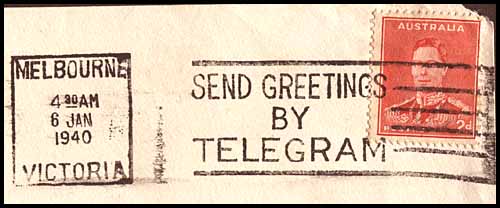 |
|
| Magazines and newspapers | 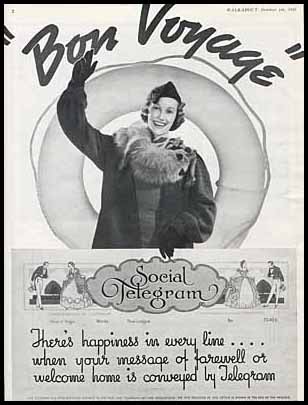 |
| Brochures:
At least six brochures were prepared. These were made available on Post Office counters and were also enclosed, along with a telegram, in delivery envelopes. |
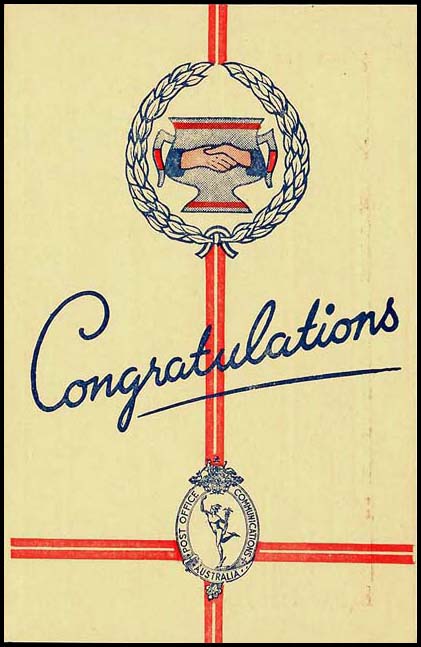 |
| In special booklets - only two types were ever issued. | |
The 1937 edition: Size: 140 × 210 mm. Rated: RRRR. Number in the Census: - 3. Provenance: Rod Perry, Johnstone |
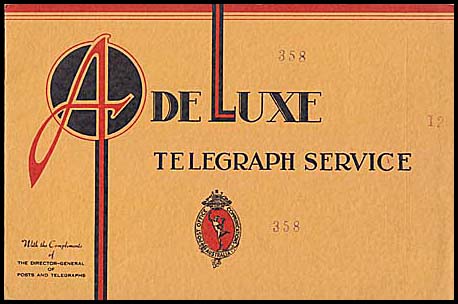 The 1937 Advertising Book. |
| The second known example has a letter dated 11 May 1937 to Mr. Lannoy at Rose Bay from the Deputy Director P&T and the delivery envelope. Provenance: Johnstone. A third example was sold at an Abacus Auction. |
|
| The 1940 edition:
Size: 137 × 216 mm. Rated: RRRRR Number in the Census: 1. Provenance: Johnstone. |
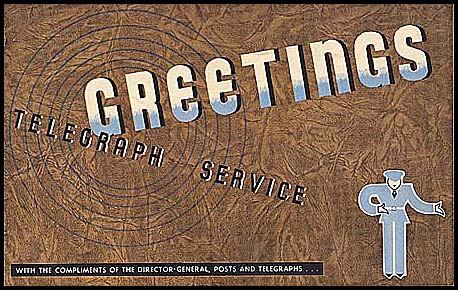 The 1940 Advertising Book. |
| War slogans - behaviour | |
| War slogans - investment. | |